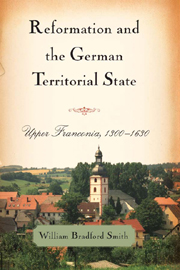Book contents
- Frontmatter
- Contents
- List of Illustrations
- List of Abbreviations
- Acknowledgments
- Introduction
- Chapter 1 Territory and Community
- Chapter 2 Rebellion, Representation, and Reform
- Chapter 3 “Lord in Our Own House”
- Chapter 4 Reformation and Revolution
- Chapter 5 The Limits of Obedience
- Chapter 6 A Plague of Preachers
- Chapter 7 Orthodoxy and Order
- Chapter 8 The Christian Commune
- Chapter 9 Cuius Regio?
- Chapter 10 The Stool of Wickedness
- Conclusion
- Notes
- Bibliography
- Index
Chapter 1 - Territory and Community
Published online by Cambridge University Press: 12 September 2012
- Frontmatter
- Contents
- List of Illustrations
- List of Abbreviations
- Acknowledgments
- Introduction
- Chapter 1 Territory and Community
- Chapter 2 Rebellion, Representation, and Reform
- Chapter 3 “Lord in Our Own House”
- Chapter 4 Reformation and Revolution
- Chapter 5 The Limits of Obedience
- Chapter 6 A Plague of Preachers
- Chapter 7 Orthodoxy and Order
- Chapter 8 The Christian Commune
- Chapter 9 Cuius Regio?
- Chapter 10 The Stool of Wickedness
- Conclusion
- Notes
- Bibliography
- Index
Summary
The formation of the territorial state provides a central–if not the central–dynamic in the history of late-medieval Germany. The charters and other documents collected in the protocol books of the vicar general's court provide ample evidence for the growth of the territorial state from the mid-thirteenth century onward. They indicate a demographic shift in the later Middle Ages, as new settlements were founded and some older ones were abandoned. They show the final dissolution of the manorial constitution and the emergence of free villages and towns. In the patterns of endowments and patronage, they chart the rise of the territorial nobility and the third estate. The development of the territorial state is often taken as a sign of political chaos–the codification of anarchy–following the death of Frederick II. In truth, the process of territorial state formation was well under way during the reigns of the later Hohenstaufen emperors. Far from serving as indicators of political collapse, the emergence of the territorial states revealed a growing sophistication of governance. Jan Dhondt's characterization of the rise of territorial principalities in post-Carolingian Neustria may well be used to describe the situation in post-Hohenstaufen upper Germany: the rise of territorial states marks an intensification of lordship on the local level.
But there was more to the development of the state than politics. The charters preserved in the Protokollenbücher suggest that the line between secular and spiritual lordship was often difficult to discern.
- Type
- Chapter
- Information
- Reformation and the German Territorial StateUpper Franconia, 1300–1630, pp. 9 - 25Publisher: Boydell & BrewerPrint publication year: 2008



